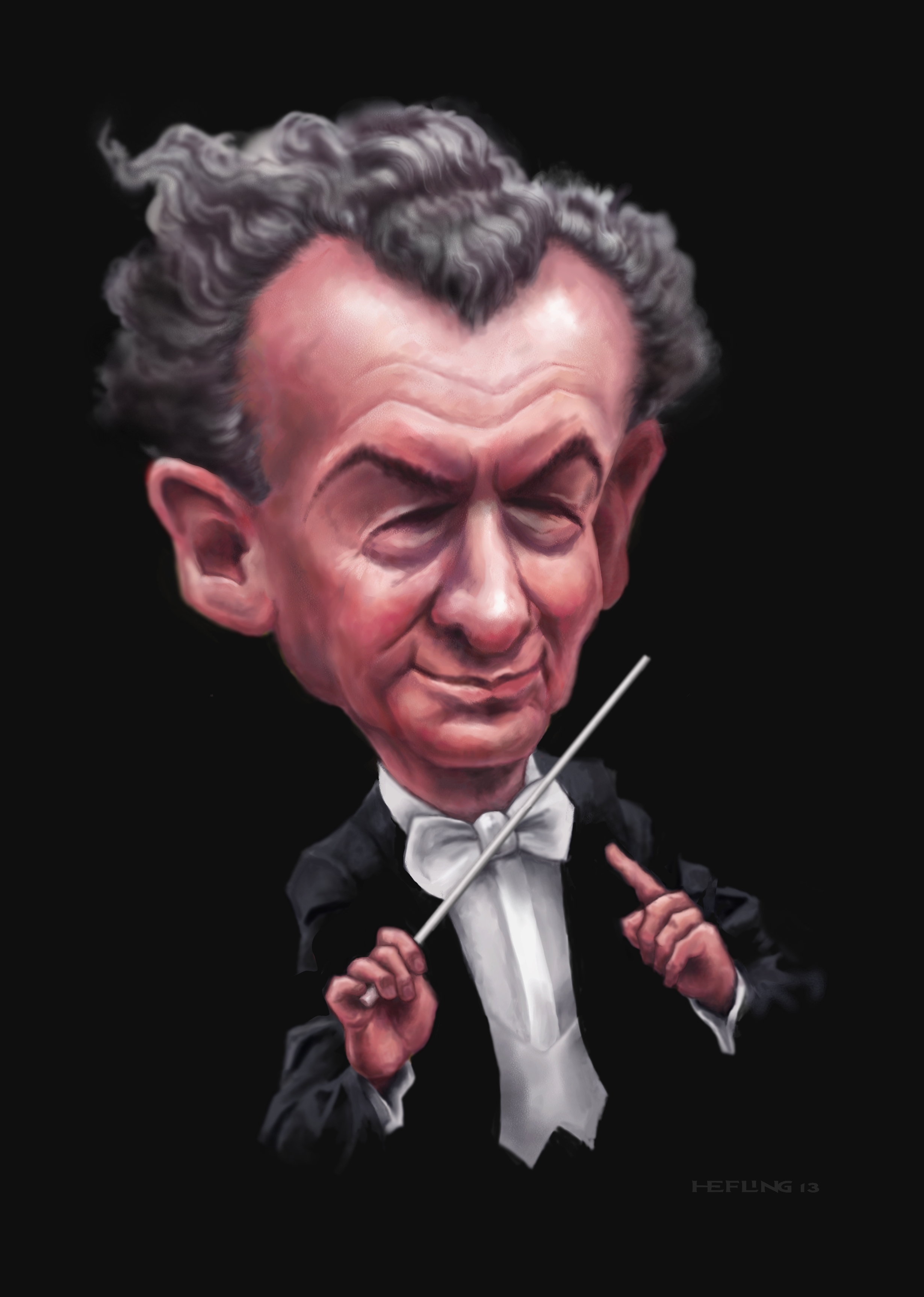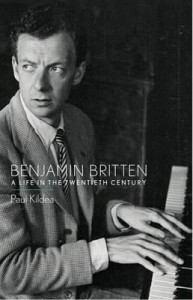 Benjamin Britten: A Life in the Twentieth Century
Benjamin Britten: A Life in the Twentieth Century
by Paul Kildea
Penguin Global. 668 pages, $45.
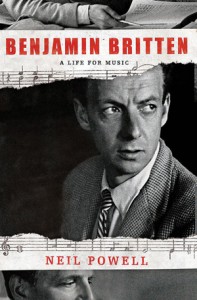 Benjamin Britten:
Benjamin Britten:
A Life for Music
by Neil Powell
Henry Holt. 528 pages, $37.
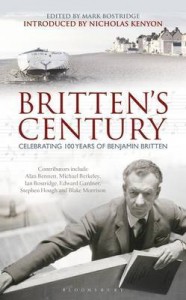 Britten’s Century: Celebrating 100 Years of Benjamin Britten
Britten’s Century: Celebrating 100 Years of Benjamin Britten
Edited by Mark Bostridge
Bloomsbury Continuum.
208 pages, £16.99
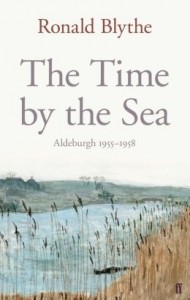 The Time by the Sea:
The Time by the Sea:
Aldeburgh 1955-1958
by Ronald Blythe
Faber & Faber UK. 272 pages, £15.99
ALAN BENNETT’S PLAY The Habit of Art, staged at London’s National Theatre in 2010, was ahead of the game in foreshadowing the inevitable revival of interest in England’s most important 20th-century composer, which coincides with the centenary of Benjamin Britten’s birth. New productions or revivals of all of the composer’s operas are to be seen, most spectacularly, recently, in the Aldeburgh Festival, which Britten founded, where Peter Grimes was triumphantly staged on a mock-up ship on the beach itself. (The production has been filmed and is being edited for theatrical release soon).
In the play, Bennett uses an imaginary meeting between Britten and former friend and librettist-collaborator, the poet W. H. Auden, at a time when Britten, in terminally poor health, was composing his last outstanding work, the opera Death in Venice. The pair had not merely been close as young men, they had even shared a Bohemian enclave in Brooklyn in 1940-41, along with Peter Pears, Britten’s partner; Carson McCullers, the Southern gothic novelist and dipsomaniac; novelist and composer Paul Bowles and his wife, author Jane Bowles; Northern Irish poet Louis Macneice; and Thomas Mann’s sons, Golo and Klaus. Gypsy Rose Lee—stripper, actress and self-proclaimed popular writer—stayed occasionally too, just to make sure things never grew quiet.
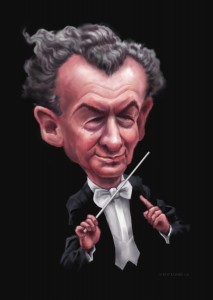 The encounter, a fantasy on Bennett’s part, allowed him to examine two fundamentally incompatible views of the act of creation and the social role and status of the artist. Auden felt he was an iconoclast—in youth, at least—and that the artist, in order to create, must live at the margins, attacking the political mainstream and the establishment. He abhorred Britten’s innately assimilative and unchallenging social character until his death in 1973. (Britten, six years Auden’s junior, would die just three years later, much regretting their alienation but continuing to justify it on grounds that Auden had been an intellectual “bully.”) The composer’s apparent sexual unadventurousness was taken as evidence of repression by Auden, who also turned on Britten for his pursuit of pre- or barely pubescent boys.
The encounter, a fantasy on Bennett’s part, allowed him to examine two fundamentally incompatible views of the act of creation and the social role and status of the artist. Auden felt he was an iconoclast—in youth, at least—and that the artist, in order to create, must live at the margins, attacking the political mainstream and the establishment. He abhorred Britten’s innately assimilative and unchallenging social character until his death in 1973. (Britten, six years Auden’s junior, would die just three years later, much regretting their alienation but continuing to justify it on grounds that Auden had been an intellectual “bully.”) The composer’s apparent sexual unadventurousness was taken as evidence of repression by Auden, who also turned on Britten for his pursuit of pre- or barely pubescent boys.
Britten’s life has been tackled before—by Humphrey Carpenter in 1992, controversially, and by John Bridcut in his more nuanced study, Britten’s Children (2006). Still, much has remained mysterious or contested since his death in 1976. Two new biographies now step into the breach, and they offer contrasting emphases. Neil Powell is not a musicologist and so offers somewhat impressionistic if evocative summaries of the mood and importance of Britten’s major compositions. As a poet, he writes with great verve and literary effect, and his deep knowledge of English literature and the ways in which its romantic strain in particular worked upon Britten are full of insight. Powell is particularly good on what the idiosyncratic East Anglian poet, clergyman, and surgeon George Crabbe (1754-1832) came to mean for Britten, and how his 1810 poem “The Borough” inspired Britten’s great operatic breakthrough Peter Grimes, which premiered in a bombed-out London in 1945 and has not left the classical repertoire since. Britten adjusted the character of Grimes significantly from Crabbe’s source text. As a social outsider accused of the murder of a boy, Crabbe could be interpreted as representing “outsider” status in other terms. Author Colin MacInnes, for instance, concluded simply in his journals that “Grimes is the homosexual hero. The melancholy of the opera is the melancholy of homosexuality.”
The true subject of both Britten’s adaptation and Crabbe’s source text, however, is surely the peculiar, inward-looking, fatalistic, and tragic seaside community that turns on Grimes. Crabbe’s “borough” was based on his home town of Aldeburgh, a small, very remote fishing town in the county of Suffolk. Britten had been born in nearby Lowestoft, a larger town but still characteristically provincial and remote from the political threnody of the London musical world. As a student he had based himself, more or less unhappily, in the capital; had fled for America along with Auden and Isherwood before the outbreak of World War II—but unlike them, had grown to hate the urban sprawl of the places in which he tried to settle (New York, Los Angeles). By 1942, he and Peter Pears determined to return to England, registering successfully as conscientious objectors. From then on, Britten sought to spend as much time as possible in Aldeburgh, or nearby, while Pears’ international singing career often took him away for long spells.
In 1948, tired of traveling the globe to perform and promote his own compositions, Britten faced a personal dilemma: while he thirsted for a cosmopolitan musical environment, he despised the English musical establishment, and he could only selectively enjoy travels abroad. He needed, above all, something that Pears did not—to feel rooted, and for this, only Suffolk might do. It was a preposterous notion in a time of national austerity and rationing, especially given the town’s remoteness, but Aldeburgh became home to a musical festival attracting performers and composers of international renown—as it still does today.
As Paul Kildea’s subtitle announces, his own biography is informed by both musical insight and socio-political contextualization. A former head of music at the Aldeburgh Festival, he knows the history and archives inside out. The result is a comprehensive treatment of Britten’s life and work, which, however, is sometimes less sprightly in its execution, and includes some phrasing that approaches the obscure, such as the claim that Britten’s “childhood was a rich vein, which he mined throughout his life, but he also fossicked far from it to hypnotic effect.”
Kildea invokes the examples of Arthur Miller and Tennessee Williams to justify his emphasis on Britten’s life and career as representative 20th-century phenomena. Yet, like Williams, Britten’s self-presentation and self-estimation make him an unlikely vector for generalized statements about the century, or England in either its pre-war or post-war manifestations. Both Williams and Britten were fundamentally indifferent to the wider concerns of the world they inhabited, even as it indirectly became caught in the prism of their greatest works. They were also, throughout, so extensively self-involved, wrestling with inner demons, that they remain above all individualistic and hard to assimilate to any national or widespread æsthetic tendency.
Kildea’s volume has attracted much attention for its one “killer claim”: the revelation that Britten’s death—officially attributed to heart failure, the consequence of a lifelong cardiac impediment—might have been caused by tertiary (untreatable) syphilis. This disease, Kildea concludes, must have been transmitted by Pears, a renowned socialite and frequenter of gay bars on several continents. Britten himself certainly knew nothing of the diagnosis, if indeed his physicians had made it. Critical debate on this matter continues—not least since Kildea’s sources are entirely oral, and third-hand, as the doctor who would know is no longer with us. What’s more, Britten’s consulting cardiologist has described the insinuation as “complete rubbish.”
And yet, if this theory holds true, there’s an extraordinary dramatic irony in Britten’s choice of Thomas Mann’s 1912 novella Death in Venice as the source for his final opera. The book recounts the last days in the life of Gustav von Aschenbach, who, mesmerized by the beautiful youth Tadzio, fails to leave Venice despite a cholera scare, until he too succumbs to the epidemic. Britten’s awareness of his own frailty profoundly permeates the opera. Pears, often absent during Britten’s protracted decline, was markedly impatient with his lover and seems (probably in denial) to have attributed it to a psychological weakness. Here too Auden may have played an indirect role, given his advocacy in the 1930s of quack theories about illness being psychically willed or self-induced, in particular as a result of repression.
Britten’s language, of course, was music rather than speech. “I have always found reading music easier than reading books,” he conceded in 1962. Lacking the broad education—invariably from Oxford or Cambridge—drawn upon in conversation by members of Auden’s circle in the 1930s and ’40s, Britten grew quiet, indeed resentful of what he saw as dogmatism, pretension, or being “grand,” as he described the upper-middle-class novelist and friend of Auden, Christopher Isherwood.
In 1937, Isherwood persuaded Britten to accompany him to the notorious Jermyn Street baths, one of the few reliable redoubts for homosexual liaisons. Britten noted privately: “Very pleasant sensations—completely sensuous, but very healthy. It is extraordinary to find one’s resistance to anything gradually weakening.” It was not, however, to be so much a gradual weakening as an intermittent one, impeded by the conservative values in which he had grown up and which he never relinquished. Just a year before, led astray in Barcelona to a permissive Chinatown nightclub, Britten had recoiled at the “not particularly pleasant experience”: “The dancing—mostly male (and dressed as females) is very lovely. But my god the sordidity—and the sexual temptations of every kind at each corner.” Within a couple of years he would take up with Pears following a long friendship, and there are few if any accounts of erotic dalliances on Britten’s side once they formed a couple.
His lack of intellectual confidence led Britten to avoid much public commentary on his compositions. He never sought to enlighten his public as to their “meaning.” When asked about the common themes that run through his operas, he conceded that Peter Grimes, Billy Budd, and A Midsummer Night’s Dream (1960) shared the theme of betrayal. This was an informative statement, since Britten’s entire career was characterized by real or imagined antagonism, caused by conductors, musicians, singers, critics, and most of those who penetrated his private life. Kildea sketches the slow, steady hardening of Britten’s character, his progressive difficulty in sharing his ideas, aspirations, and personal space.
If reclusiveness and aloofness were both already characteristics of the young composer, isolation and mistrust marked the older man. Ronald Blythe’s memoir about his time working for the Aldeburgh Festival pithily summarizes Britten’s reputation: “he could only love or hate, it was said”; he had a “dislike of other people’s projects.” Britten could readily detach himself from longstanding collaborators without explanation, such as Eric Crozier, the director of the first production of Peter Grimes at Sadlers Wells and librettist of his one attempt at a comic opera, Albert Herring (1947).
Other librettists came and went, including two “fellow travelers”: Forster, whose remarkable libretto for Billy Budd Britten contested at many points, and South African-born William Plomer, who collaborated with Britten on the 1953 nationalist and monarchist opera Gloriana, which was attended by the newly-crowned Queen Elizabeth. All were by turns bewildered and even embarrassed by the production’s depiction of the relationship between the first Queen Elizabeth and the Earl of Essex, informed by the warts-and-all biography by Lytton Strachey, Elizabeth and Essex: A Tragic History (1928), which portrayed the Queen as a sympathetic figure, but also clearly flawed, if not emotionally stunted. The audience was notoriously cool in its reception of this work.
In 1954’s The Turn of the Screw, based on Henry James’s ghostly novella, the tensions fundamentally revolve around the question of the moral character of its children, including a boy named Miles. In staging the work, Britten came up against an unexpected complexity: not the temperament of the boy who first played Miles but his appearance. David Hemmings was a precocious thirteen-year-old, aware of his own charisma and of the effect it produced on many adults, not least the opera’s composer. Hemmings’ 2004 memoir Blow Up insists that Britten’s intentions were entirely solicitous and kindly (“not only a father to me, but a friend”), though our sense of what is proper between the generations has changed so much that it’s incredible to think that Britten had Hemmings stay with him for long periods in Suffolk, allowing him to climb into his bed whenever frightened by the lashings of the North Sea. Comically, in dispatching him, Hemmings’ true father had warned his son directly, “You know he’s a homo, don’t you?” Hemmings turned out, like virtually all of the juvenile objects of Britten’s attention, to be straight or, in his own words, “more heterosexual than Genghis Khan.” Kildea argues persuasively that Britten may have chosen as his objects of affection only boys who did not strike him as (so the parlance then had it) “musical” or “queer,” an instance of subconscious self-protection.
The “emphatically good-looking” (in John Bridcut’s words) Piers Dunkerley was also thirteen when Britten got to know him, though the composer was just seven years older. In his diary—the same schoolboy’s ledger he would use all of his life—Britten wrote of Dunkerley: “tell it not in Gath,” a Biblical phrase taken from II Samuel’s account of the love between David and Jonathan. Here Kildea and Powell differ. Kildea finds the choice of phrase knowing and resonant; Powell argues that it was a sort of acquired shorthand, probably used between Britten and his peers at school, for anything that might best be kept secret. “What a boy to help!” continued Britten later. “So splendid in brain and form.” At his school, Bloxham, he added, “they can’t leave a nice lad like Piers alone—but it is understandable—good heavens!”
Britten often described his own feelings toward others as “paternal.” Later in life, he and Pears even fantasized about adopting a son. And yet again the diary entries edge toward something quite different: “He [Dunkerley] is a nice thing, and I am very fond of him—thank heaven not sexually, but I am getting to such a condition that I am lost without some children (of either sex) near me.” To state the obvious, Britten’s feelings never directed themselves towards girls. Still, the self-consciousness in this particular entry is remarkable. One feels the composer staring into the abyss, confronting fully, though not conceding anything to, this unnamable love.
Dunkerley fought in World War II but survived, only to commit suicide later in wretched personal circumstances. Britten was as wounded by this as by the loss of three close friends in combat, and included Dunkerley among the dedicatees of the War Requiem, which both biographers acclaim as Britten’s best non-operatic hour, premiering in the rebuilt Coventry Cathedral in 1962. Britten’s original intention—to have the work sung by a Russian, a German, and an Englishman—was thwarted by Moscow. But the universality of Britten’s theme, informed by his lifelong pacifism, was lost on no one. In Wilfrid Owen’s poetry, Britten had found a fine lyrical complement to his remarkable, confident, and mature musical vision. The homoerotic subtext to poems such as “Anthem for Doomed Youth” and “Strange Meeting” is a commonplace today, and the biographical facts that support such a reading widely accessible. But in the 1960s, such readings were couched in circumlocution. Yet clearly, again, Britten was drawn to a meditation on young male promise and young male beauty.
Britten’s reputation today feels internationally secure, though both biographies sketch the extraordinary obstacles he faced in forcing an entrenched and cautious musical establishment and general public to appreciate the experimentation of the Continent—from Schoenberg and Berg’s atonalism to Stravinsky’s embrace of folk sources. It is a supreme paradox that Britten did this not as a metropolitan power broker but as a self-confessed believer in the small, local, or provincial who nurtured his own, initially tiny festival without adequate venues, infrastructure, or financial backing. He later steered through the building of a large-scale venue nearby, Snape Maltings, with its beautiful construction, idyllic setting, and superlative acoustics.
Britten transformed the legitimate subject of opera. In Billy Budd, he pioneered the notion of an all-male opera, something previously inconceivable. Not everyone was impressed. The disaffected Eric Crozier later formed the hostile opinion that “homosexuality was the predominant influence in the choice of subjects for his operas. He had all the capacity for a great opera-composer … but he lacked the essential humanity; the broad range of compassion and understanding necessary for the purpose.” Crozier had been slighted, but the inaccuracy of the judgment stands side-by-side with its palpable homophobia. It is no different from the historic objections to Michelangelo’s Sonnets because of the gender of the beloved. These were strikingly set to music by Britten, for Peter Pears to perform, a collaboration as coded yet as clear as their social inseparability. It all went without saying yet was fully transparent.
In such cases, the meaning or impact of a creative work can be traduced by excessive or simplistic biographical readings. But if we attempt to discount the importance of Britten’s sexuality entirely, we run into precisely the opposite problem: that the works collectively make much less sense. There is also the testimonial power both of Britten and Pears’ own correspondence and the composer’s diaries. Responding to Britten’s concerns over being marginalized by a conservative English society, for example, Pears once responded: “We are after all queer & left & conshies [conscientious objectors]which is enough to put us, or make us put ourselves, outside the pale, apart from being artists as well.”
Not all are convinced. Thomas Adès, the most acclaimed English composer to emerge since Britten, and also a former artistic director of Aldeburgh, has described as “stupid” the notion that Britten derived his creative energies from his sexual marginality. Adès has also questioned Britten’s overall achievement, describing much of his œuvre as “pat.” Nevertheless, we inhabit a quite different social circumstance today and need, as Peter Parker argues in his essay “Britten and the Gang” (in Britten’s Century), that for almost all of Britten’s life, prejudice against homosexuality was quite pronounced. Until the passing of the 1967 Sexual Offences Act, by which male homosexual acts were partly decriminalized, gay men found guilty of such offenses could expect a mandatory two-year prison sentence.
Across the arts, a helpful 20th-century analogy might be made with the example of two very different temperaments. Some three decades earlier, Vaslav Nijinsky, encouraged by Serge Diaghilev in the Ballets Russes, had allowed, both in his own performance and, in his subsequent choreography, male athleticism and beauty to occupy the stage as centrally as ballerinas previously always had. Curiously, Britten himself was dismissive of ballet and only toyed with it significantly once, in 1957’s The Prince of the Pagodas. It is a winning, generally underestimated work, though its Orientalist leanings would find no counterpart in the radical, yet at the same time very English operatic works for which he is justly admired.
Britten was an islander: he remained wedded to the sound, sight, and effects of the sea. As Ronald Blythe puts it, “he was oceanic from the start.” By contrast, Blythe writes, “at first I thought that to ‘look’ at the sea was a landman’s compulsion. Britten watched it all the time. … A pearly distance was … the sea! It possessed its own talk.” Likewise Britten’s musical legacy is, in his centenary year, fully appreciated for what it equally possesses: its own, unmistakable, and remarkable language.
Richard Canning’s most recent publication is an edition of Ronald Firbank’s novel Vainglory for Penguin Classics (2012).


